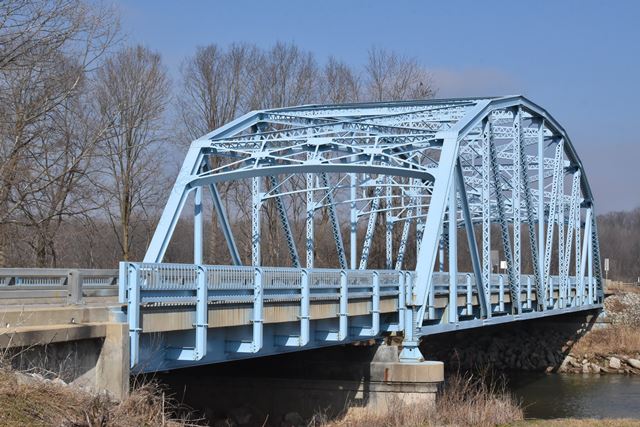We Recommend:
Bach Steel - Experts at historic truss bridge restoration.
BridgeHunter.com Phase 1 is released to the public! - Visit Now
IN-75 Bridge
Cutler Bridge, State Highway Bridge 3653

Primary Photographer(s): Nathan Holth
Bridge Documented: February 19, 2017
Rural: Carroll County, Indiana: United States
Metal 8 Panel Rivet-Connected Parker Through Truss, Fixed and Approach Spans: Metal Stringer (Multi-Beam), Fixed
1948 By Builder/Contractor: R. L. Schutt of Indianapolis, Indiana
2001
175.0 Feet (53.3 Meters)
240.0 Feet (73.2 Meters)
28 Feet (8.53 Meters)
1 Main Span(s) and 1 Approach Span(s)
24970

View Information About HSR Ratings
Bridge Documentation
View Archived National Bridge Inventory Report - Has Additional Details and Evaluation
This is a well-preserved example of a state highway Parker truss in Indiana noted for its arched portal bracing.
Information and Findings From DHPA Historic Bridge SurveyStatement of Significance R. L. Schutt of Indianapolis, Indiana, won an $118,373.20 contract in July 1947 to build a two-span, state-design structure consisting of a 61-ft. 6-in. I-beam approach and a 175-ft. Parker through-truss upon a concrete substructure. The bridge was officially not completed until the beginning of March, 1948. The ISHC used a revised version of its fifth-generation standard plan #1551 for a 175-ft., riveted, Parker through-truss span with a 28-ft. roadway plus a pair of 2-ft. walks also inside the trusses. Truss depth varied from 23 ft. at the portal to 34 ft. 4 in. at midspan. Each truss carried eight panels, the outer two at 20 ft. 3 in. and the inner four at 23 ft. 6 in. Every top chord member is differently sloped; none is parallel with the lower chord; and all were fabricated from a pair of 15- in. channels (@40# for the endposts, third, and fourth panels, and @53.9# for the second). For the lower chord, 10-in. I-beams grow in weight from the outer panels (@66#) to the inner-most one (@100#). The state used rolled I-beams in some truss web members. The verticals or posts consist of two forms and weights: the hip and the fourth are 10-in. I-beams (@33#); the second and third are fabricated from a pair of laced 10-in. channels (@15.3#). To protect the quite-tall trusses against wind and vehicle-induced stress, substantial latticed struts and heavy upper sway framing buttress the verticals above 15 ft. of roadway clearance. The portals used latticed sections, too. While a 10-in. I-beam (@37#) provided the second-panel diagonal, the others used a pair of laced 10-in. channels (@15.3#). None of the panels was countered. The ISHC prescribed 33-in. I floor-beams (@200#) riveted to the verticals above the lower chord. Ten rows of rolled I-beam stringers attached to the floor-beams' sides varied in depth and weight by placement. The 20-ft. panels used 16-in. Is; the 23-ft. 6-in. ones relied on 18-in Is. Outside stringers were lighter than inner ones. Weights varied on 20-ft. panels from 36 lbs. (outer) to 50 lbs (inner); on the 23-ft. panels from 50 lbs to 55 lbs. Together, the floor-beams and the stringers carry the concrete deck. Angles supply each lower sway-bracing member. Tube-channel-and- post rails lined the inner sides of the trusses, and coped concrete approach rails with bush- hammered panels funneled traffic into the spans. This bridge provides one of several extant--and certainly one of the latest--examples of this fifth-generation standard plan for a fairly-long through-truss span. The trusses retain their original members. The metal guardrails and the concrete approach ones remain. The concrete deck has been replaced. Other Information References Indiana State Highway Commission, Structure, #75-J-3653; Contract, #2814; Superstructure Standard, #1551. Bridge Considered Historic By Survey: Yes |
![]()
Photo Galleries and Videos: IN-75 Bridge
Bridge Photo-Documentation
Original / Full Size PhotosA collection of overview and detail photos. This gallery offers photos in the highest available resolution and file size in a touch-friendly popup viewer.
Alternatively, Browse Without Using Viewer
![]()
Bridge Photo-Documentation
Mobile Optimized PhotosA collection of overview and detail photos. This gallery features data-friendly, fast-loading photos in a touch-friendly popup viewer.
Alternatively, Browse Without Using Viewer
![]()
Maps and Links: IN-75 Bridge
Coordinates (Latitude, Longitude):
Search For Additional Bridge Listings:
Bridgehunter.com: View listed bridges within 0.5 miles (0.8 kilometers) of this bridge.
Bridgehunter.com: View listed bridges within 10 miles (16 kilometers) of this bridge.
Additional Maps:
Google Streetview (If Available)
GeoHack (Additional Links and Coordinates)
Apple Maps (Via DuckDuckGo Search)
Apple Maps (Apple devices only)
Android: Open Location In Your Map or GPS App
Flickr Gallery (Find Nearby Photos)
Wikimedia Commons (Find Nearby Photos)
Directions Via Sygic For Android
Directions Via Sygic For iOS and Android Dolphin Browser
USGS National Map (United States Only)
Historical USGS Topo Maps (United States Only)
Historic Aerials (United States Only)
CalTopo Maps (United States Only)

